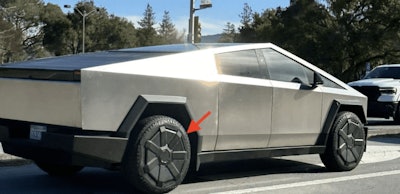
Toronto, Ontario — In this weekly electric and autonomous vehicle report, the wheel covers of the Tesla Cybertruck are reportedly eating away at the wheels; while engineers at Duke University have created a technology to make autonomous vehicles hallucinate.
Aero eats away
Early adopters of Tesla’s Cybertruck have found that the vehicle’s aero wheel covers are eating away at the sidewall of their tires.
The factory tires on the Cybertruck are specifically made for the vehicle by Goodyear and come equipped with custom sidewalls. The hard plastic covers found on the tires function similarly to the ones found on the Model 3, are removable and meant to improve the Cybertruck’s range.
However, the covers also extend past the actual wheels themselves and mesh into the design of the aero cover.
Tesla originally anticipated that the cover would make contact with the tire itself and so made the ends of the cover a softer, flexible rubber compound that wouldn’t dig into the sidewall. The covers were also designed to be spaced out from the edge of the tire by several milimetres so that they would not actually make contact with the wheel.
Unfortunately, the heaviness of the Cybertruck due to its design and electric vehicle status means that early adopters have found that the vehicle deforms the bottom tire outward at the contact patch where the tire meets the ground.
In turn, this deformation causes the aero covers’ rubber to make contact with the sidewall of the tire, and with each rotation of the sidewall, the rubber caps of the aero cover rub and wear down the tire itself.
Tesla has since acknowledged this issue and currently, the aero covers are unavailable until at least March as the automaker works on resolving the issue.
Redirecting radar
Engineers at Duke University in North Carolina recently demonstrated a system they’ve dubbed “Mad-Radar” intended to fool autonomous vehicle radars into believing unreal road conditions are occurring.
Led by Miroslav Pajic, the Dickinson Family Associate Professor of Electrical and Computer Engineering and Tingjun Chen, assistant professor of electrical and computer engineering, the technology can hide the approach of an existing vehicle, create a phantom car where none exists and even trick an autonomous vehicle into thinking a real car has quickly deviated from its actual course.
During their demonstration of “Mad-Radar,” Pajic and Chen noted that hacking into an autonomous vehicle’s radar using their technology can be done without having any prior knowledge of the specific settings of the victim’s vehicle radar.
They believe that their research helps show that manufacturers should immediately begin taking steps to better safeguard things like self-driving vehicles and they designed “Mad-Radar” with the intention of promoting future safety by pointing out cybersecurity weak spots.
Pajic and Chen’s research will be published in 2024 at the Network and Distributed System Security Symposium to take place February 26 in San Diego, California.





















